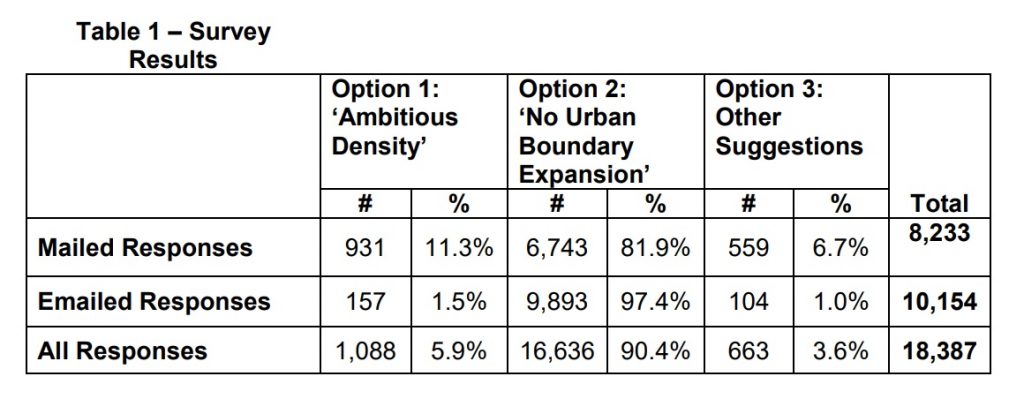90% ‘no’ response to Hamilton’s ‘ambitious density’ proposal in urban boundary survey
Published September 18, 2021 at 12:06 am

Hamiltonians want some three thousand acres of farmland protected from development during a climate crisis.
Whether Hamilton city councillors and Mayor Fred Eisenberger will agree with that sentiment on Oct. 25 will be another story. That is the date when they are expected to vote on the urban boundary expansion that has been suggested as a way to meet population and job growth targets 30 years from now that have been set by the Ford Government.
However, it is apparent that the city was ratioed in theurban boundary survey that it conducted over a span of four weeks in the summer. More than 15 times as many respondents to the survey are opposed to expanding the urban boundary than are in favour of doing so.
The negative response was 7.2 times higher among people who answered by formal mail, and about 65 times higher among those who responded through e-mail. The survey, which was sent to each Hamilton household in late June, included a third option where residents could suggest alternatives.

Combined, out of 18,387 responses that were received and deemed acceptable, only 5.9 per cent, or 1,088, backed Option 1, the ‘Ambitious Density’ scenario. That option would involve expanding the urban boundary and allowing development on 1,340 hectares of farmland, mostly south of the city.
The ‘No Urban Boundary Expansion’ option was selected by 16,636 respondents, which works out to 90.4 per cent.
Also, 663 people (3.6 per cent of those surveyed) took the opportunity to make suggestions.
In August, Ward 9 City Councillor Brad Clark said the responses he was copied on were 99.9 per cent negative. Only seven of the 8,265 responses that Clark’s office viewed were either in favour of Ambitious Density or had a suggestion.
The city’s general issues committee agreed to conduct the mail-out survey on March 29. Dozens of citizen delegations made presentations arguing for the urban boundary to remain untouched.
Ontario’s Ministry of Municipal Affairs and Housing has declared that cities must plan to accommodate provincial growth forecasts over the next 30 years through to 2051. Hamilton is expected to have a plan to accommodate 236,000 more people and 122,000 more jobs.
In June, the very same week the urban boundary survey began, the Smart Prosperity Institute released a report that showed why many young families are leaving Hamilton due to a lack of appropriate housing. Its senior director, Dr. Michael P. Moffatt, also told InSauga that the city will have to find “a way to build more family-friendly, more climate-friendly housing that’s affordable, (so) you’ll have better economic outcomes and environmental outcomes.”
The report that the general issues committee will receive summarizes similar concerns, from those on both sides of the debate.
Some of the main reasons from ‘Ambitious Density’ supporters included:
- Having housing options “other than predominately apartment units”;
- Lack of housing supply catered to families;
- Affordability;
- Focused intensification along transportation corridors;
- Farmers being able to sell their land for development;
- Increased development in rural settlements.
The main points from vastly larger group of ‘No Urban Boundary Expansion’ supporters voiced included:
- Hamilton having an abundance of vacant lots and buildings that could be redeveloped to “to improve access to housing and to improve the aesthetic character of the city”;
- Climate change;
- Infrastructure expansion to new areas, when the city already has an infrastructure deficit;
- Farmland protection to ensure adequate food security;
- Active transportation and creating a more walkable city;
- Concern that urban expansion will not help people experiencing housing access limitations and homelessness.
- Adding medium density with more midsize buildings and townhouses.
Another prevalent suggestion from the “No” contingent was that the provincial forecasted growth of 236,000 people by 2051 is too high.
The report about the responses was prepared by Lauren Vraets, a planner with the city.
More information about the city’s planning is available at engage.hamilton.ca/grids2mcr.
insauga's Editorial Standards and Policies advertising





